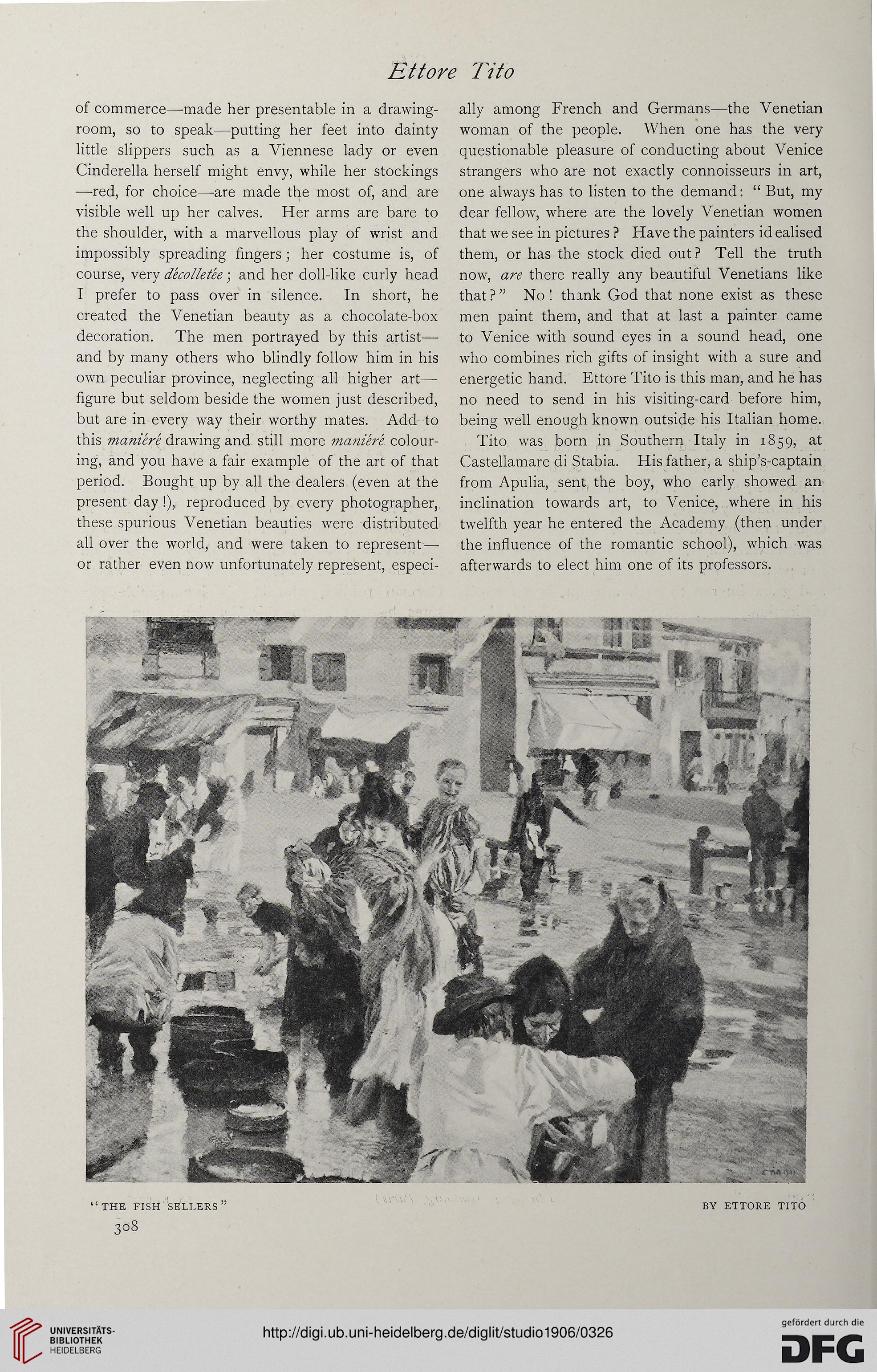Ettore Tito
of commerce—-made her presentable in a drawing-
room, so to speak—putting her feet into dainty
little slippers such as a Viennese lady or even
Cinderella herself might envy, while her stockings
—red, for choice—-are made the most of, and are
visible well up her calves. Her arms are bare to
the shoulder, with a marvellous play of wrist and
impossibly spreading fingers; her costume is, of
course, very decolletee; and her doll-like curly head
I prefer to pass over in silence. In short, he
created the Venetian beauty as a chocolate-box
decoration. The men portrayed by this artist—
and by many others who blindly follow him in his
own peculiar province, neglecting all higher art—
figure but seldom beside the women just described,
but are in every way their worthy mates. Add to
this maniere drawing and still more manieri colour-
ing, and you have a fair example of the art of that
period. Bought up by all the dealers (even at the
present day !), reproduced by every photographer,
these spurious Venetian beauties were distributed
all over the world, and were taken to represent-
or rather even now unfortunately represent, especi-
ally among French and Germans—the Venetian
woman of the people. When one has the very
questionable pleasure of conducting about Venice
strangers who are not exactly connoisseurs in art,
one always has to listen to the demand: “ But, my
dear fellow, where are the lovely Venetian women
that we see in pictures ? Have the painters id ealised
them, or has the stock died out? Tell the truth
now, are there really any beautiful Venetians like
that?” No! thank God that none exist as these
men paint them, and that at last a painter came
to Venice with sound eyes in a sound head, one
who combines rich gifts of insight with a sure and
energetic hand. Ettore Tito is this man, and he has
no need to send in his visiting-card before him,
being well enough known outside his Italian home.
Tito was born in Southern Italy in 1859, at
Castellamare di Stabia. His father, a ship’s-captain
from Apulia, sent the boy, who early showed an
inclination towards art, to Venice, where in his
twelfth year he entered the Academy (then under
the influence of the romantic school), which was
afterwards to elect him one of its professors.
of commerce—-made her presentable in a drawing-
room, so to speak—putting her feet into dainty
little slippers such as a Viennese lady or even
Cinderella herself might envy, while her stockings
—red, for choice—-are made the most of, and are
visible well up her calves. Her arms are bare to
the shoulder, with a marvellous play of wrist and
impossibly spreading fingers; her costume is, of
course, very decolletee; and her doll-like curly head
I prefer to pass over in silence. In short, he
created the Venetian beauty as a chocolate-box
decoration. The men portrayed by this artist—
and by many others who blindly follow him in his
own peculiar province, neglecting all higher art—
figure but seldom beside the women just described,
but are in every way their worthy mates. Add to
this maniere drawing and still more manieri colour-
ing, and you have a fair example of the art of that
period. Bought up by all the dealers (even at the
present day !), reproduced by every photographer,
these spurious Venetian beauties were distributed
all over the world, and were taken to represent-
or rather even now unfortunately represent, especi-
ally among French and Germans—the Venetian
woman of the people. When one has the very
questionable pleasure of conducting about Venice
strangers who are not exactly connoisseurs in art,
one always has to listen to the demand: “ But, my
dear fellow, where are the lovely Venetian women
that we see in pictures ? Have the painters id ealised
them, or has the stock died out? Tell the truth
now, are there really any beautiful Venetians like
that?” No! thank God that none exist as these
men paint them, and that at last a painter came
to Venice with sound eyes in a sound head, one
who combines rich gifts of insight with a sure and
energetic hand. Ettore Tito is this man, and he has
no need to send in his visiting-card before him,
being well enough known outside his Italian home.
Tito was born in Southern Italy in 1859, at
Castellamare di Stabia. His father, a ship’s-captain
from Apulia, sent the boy, who early showed an
inclination towards art, to Venice, where in his
twelfth year he entered the Academy (then under
the influence of the romantic school), which was
afterwards to elect him one of its professors.




